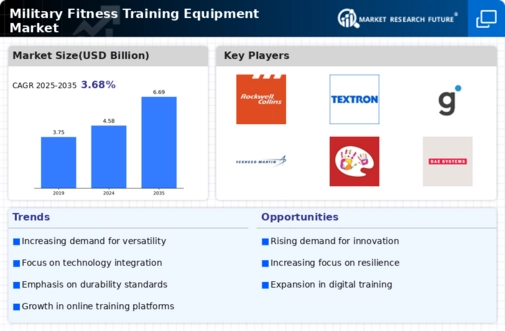Market Growth Projections
The Global Military Fitness Training Equipment Market Industry is projected to experience substantial growth over the next decade. With a market value expected to reach 4.58 USD Billion in 2024 and 6.69 USD Billion by 2035, the industry is poised for a promising trajectory. The anticipated CAGR of 3.5% from 2025 to 2035 reflects the ongoing demand for advanced training solutions. This growth is driven by various factors, including increasing defense budgets, technological advancements, and a heightened focus on physical readiness among military personnel. The market's expansion is indicative of the evolving landscape of military training and fitness.
Increasing Defense Budgets
The Global Military Fitness Training Equipment Market Industry is experiencing growth due to rising defense budgets across various nations. Countries are prioritizing military readiness and physical training, leading to increased investments in fitness equipment. For instance, the United States has allocated substantial funds to enhance the physical training capabilities of its armed forces. This trend is not limited to the U.S.; nations like India and China are also ramping up their defense spending, which is expected to contribute to the market's expansion. As a result, the market is projected to reach 4.58 USD Billion in 2024, indicating a robust demand for advanced training equipment.
Technological Advancements
Technological innovations are significantly influencing the Global Military Fitness Training Equipment Market Industry. The integration of smart technology, such as wearable fitness trackers and virtual training platforms, enhances the training experience for military personnel. These advancements allow for real-time performance monitoring and personalized training regimens, which are crucial for optimizing physical readiness. For example, the adoption of augmented reality in training scenarios is becoming more prevalent, providing immersive experiences that improve engagement. As these technologies evolve, they are likely to drive market growth, contributing to an anticipated CAGR of 3.5% from 2025 to 2035.
Focus on Physical Readiness
The emphasis on physical readiness within military organizations is a key driver of the Global Military Fitness Training Equipment Market Industry. Military leaders recognize that physical fitness is essential for operational effectiveness and soldier resilience. This focus has led to the implementation of rigorous fitness programs, necessitating the procurement of specialized training equipment. For example, the U.S. Army has introduced new fitness standards that require advanced training tools to meet these benchmarks. Consequently, this trend is expected to sustain market growth, with projections indicating a market value of 6.69 USD Billion by 2035.
Rising Awareness of Health and Fitness
Growing awareness of health and fitness among military personnel is influencing the Global Military Fitness Training Equipment Market Industry. As soldiers increasingly recognize the importance of maintaining physical health, there is a corresponding demand for high-quality training equipment that supports their fitness goals. This shift is reflected in the military's investment in modern fitness facilities and equipment, which cater to the evolving needs of service members. Additionally, initiatives promoting mental health and physical well-being are becoming integral to military training programs, further driving the demand for innovative fitness solutions.
Global Collaboration and Training Programs
International collaborations and joint training programs among military forces are contributing to the growth of the Global Military Fitness Training Equipment Market Industry. These partnerships often involve sharing best practices and resources, leading to enhanced training methodologies and equipment standards. For instance, NATO exercises frequently incorporate advanced fitness training regimens, necessitating the use of specialized equipment. Such collaborative efforts not only improve the effectiveness of training but also stimulate demand for diverse fitness solutions across different military organizations. This trend underscores the importance of adaptability and innovation in military fitness training.













